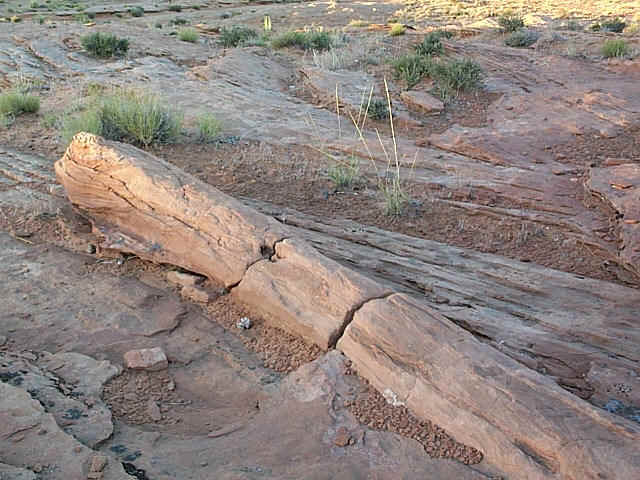
Fossilized Tree Casts or Social Insect Burrows?
New Fossil Site Found at Page, Arizona

These photographs were recently taken within City of Page limits. A stratigraphy survey conducted by Ron Blakey, NAU Department of Geology places the specimens near the very top of the Navajo Sandstone just below the J-2 Unconformity. This unconformity is an erosional surface that separates the Navajo Formation from the overlying Page Sandstone formation. These fossils date to the Middle Jurassic period and have an approximate age of 175 million years.
Fossils in the Page Sandstone Formation are virtually none existent and in the Navajo Sandstone they are relatively rare and usually of interest because they add important clues to the reconstructed Navajo Ss paleo-ecosystem and environment. This particular deposition environment was most likely a moist, damp area between eolian sand dune deposits but more will be known when Northern Arizona University completes a field survey later this year (2000). Similar environments have been associated with dinosaur tracks on the Colorado Plateau. In fact, theropod tracks have been found 1 mile from this site.
The fossil specimens found at the Page location bear a striking resemblance to fallen trees with trunk lengths that range from 10 feet to almost 18 feet long. Most of these tree-like structures come complete with short, branch-like appendages that fork in the proper upright manner. The coarse sand silica mineralization, however, does not reveal tree ring structures and other fine details of the original cell membrane which are so common in the excellently preserved samples of the Petrified Forest member of the Chinle Formation.

One possible explanation is that these structures represent fossil "casts". A cast is formed when some organic material (like a tree) is buried in sediments and eventually decomposes to leave a hollow chamber. At some later date, highly mineralized solutions can move through the sediment pores to fill the vacant cavity with new mineral deposits which then form a hardened cast in the shape of the original specimen.
Another possible theory proposed by Ron Blakey is that these structures represent large colonies of social insects. Small fossils across the general area supports the notion that the damp Navajo sand was very active biologically; although, most of this fossil evidence is on a magnitude scale 1-2 times smaller than the tree trunk casts (i.e. 1-12 inches versus 10-18 feet). Cross-section analysis of the tree trunk casts show a central core of mineralization with the outer surface of the cast deeply penetrated with sand grains that suggest that some later physical or biological activity increased the original diameter of the organic deposit. Whatever the outcome: tree casts or social insect colonies or some type of inorganic deposit. Dr. Blakey indicated that these were curious features for the Navajo Sandstone formation that deserved further study.

If you can shed any light as to the origins of these fossils, I would appreciate your interpretation and insight. Send comments to pmostapu@srpnet.com
Click here to read more about the Navajo Sandstone and the unique depositional environment that creates fossils in this sandstone formation.
Paul Ostapuk
March 2000